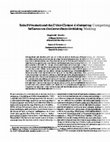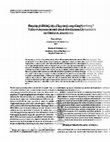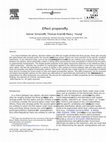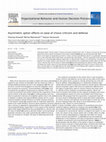Papers by Itamar Simonson
Journal of Marketing Research, 2003
Page 1. RAVI DHAR and ITAMAR SIMONSON* Whereas most academic and industry studies of consumer pre... more Page 1. RAVI DHAR and ITAMAR SIMONSON* Whereas most academic and industry studies of consumer preferences and decision making involve forced choice (ie, participants are told to choose one of the ...
Over the past few years, customer relationship management and loyalty programs (LPs) have been wi... more Over the past few years, customer relationship management and loyalty programs (LPs) have been widely adopted by companies and have received a great deal of attention from marketers, consultants, and, to a lesser degree, academics. In this research, we examine the effect of the level of effort required to obtain a LP's reward on consumers' perception of the LP's attractiveness.
SSRN Electronic Journal, 2000
... Searching for a Mate: Theory and Experimental Evidence Raymond Fisman Sheena Iyengar Emir Kam... more ... Searching for a Mate: Theory and Experimental Evidence Raymond Fisman Sheena Iyengar Emir Kamenica Itamar Simonson October 2002 ... Searching for a Mate: Theory and Experimental Evidence Raymond Fisman, Sheena Iyengar, Emir Kamenica, & Itamar Simonson * ...

Journal of Consumer Psychology, 2000
Although brand switching is one of the most researched topics in marketing, we still know very li... more Although brand switching is one of the most researched topics in marketing, we still know very little about the moderators of switching between brands in different price-quality tiers (e.g., from Haagen-Dazs ice cream to Breyers or to a store brand). Building on the notion that buyers have a (category-specific) consideration set of pricequality tiers, we propose that sales promotions and the choice set composition (or the choice context) have compensatory effects on brand switching between price-quality tiers. Specifically, if one of these factors causes buyers to switch to a higher price-quality tier within their brand-tier consideration set, then the other factor is less likely to induce switching in the same direction (to an even higher tier) and more likely to induce switching in the opposite direction. This general proposition leads to several specific hypotheses, including (a) the likelihood of switching between particular brand tiers due to price promotions can be predicted based on the choice set composition; (b) asymmetric switching, whereby consumers are more likely to switch up from a low-tier to a promoted high-tier brand than from a high-tier to a promoted low-tier brand, is reduced or eliminated if consumers consider three price-quality tiers; and (c) the compromise effect is reduced when the lowest tier brand offers a price promotion. These hypotheses were supported in a series of studies, which also examined rival explanations. The theoretical and practical implications of the findings are discussed.
Journal of Consumer Psychology, 1993
... the calcula-tor problem, each brand had about 150 functions, but one brand (Casio) had five .... more ... the calcula-tor problem, each brand had about 150 functions, but one brand (Casio) had five ... by Respondent 1 Condition (What [Real] Subjects Were Shown) Calculator School InsuranceWatch Average No ... 18 and 80 years old, with about an equal number of men and women. ...

We propose an analytical framework for studying bidding behavior in online auctions. The framewor... more We propose an analytical framework for studying bidding behavior in online auctions. The framework focuses on three key dimensions: the multi-stage process, the types of value-signals employed at each phase, and the dynamics of bidding behavior whereby early choices impact subsequent bidding decisions. We outline a series of propositions relating to the auction entry decision, bidding decisions during the auction, and bidding behavior at the end of an auction. In addition, we present the results of three preliminary field studies that investigate factors that influence consumers' value assessments and bidding decisions. In particular, (a) due to a focus on the narrow auction context, consumers under-search and, consequently, overpay for widely available commodities (CDs, DVDs) and (b) higher auction starting prices tend to lead to higher winning bids, particularly when comparable items are not available in the immediate context. We discuss the implications of this research with respect to our understanding of the key determinants of consumer behavior in this increasingly important arena of purchase decisions.
SSRN Electronic Journal, 2000
ABSTRACT We examine racial preferences in dating using data that allow for the direct observation... more ABSTRACT We examine racial preferences in dating using data that allow for the direct observation of decisions of randomly paired individuals in a Speed Dating experiment. Females exhibit stronger racial preferences than males. Furthermore, we observe stronger same race preferences for blacks and Asians than for Hispanics and whites. Accounting for self-reported shared interests considerably reduces the observed effect of racial preferences.
Quarterly Journal of Economics, 2006
We study dating behavior using data from a Speed Dating experiment where we generate random match... more We study dating behavior using data from a Speed Dating experiment where we generate random matching of subjects and create random variation in the number of potential partners. Our design allows us to directly observe individual decisions rather than just final matches. Women put greater weight on the intelligence and the race of partner, while men respond more to physical
Review of Economic Studies, 2008
We examine racial preferences in dating. We employ a Speed Dating experiment, which allows us to ... more We examine racial preferences in dating. We employ a Speed Dating experiment, which allows us to directly observe individual decisions and thus infer whose preferences lead to racial segregation in romantic relationships. Females exhibit stronger racial preferences than males. The richness of our data further allows us to identify many determinants of same race preferences. Subjects' backgrounds, including the racial composition of the ZIP Code where a subject grew up and the prevailing racial attitudes in a subject's state or country of origin, strongly influence same race preferences. Older subjects and more physically attractive subjects exhibit weaker same race preferences.
The Quarterly Journal of Economics, 2006
We study dating behavior using data from a Speed Dating experiment where we generate random match... more We study dating behavior using data from a Speed Dating experiment where we generate random matching of subjects and create random variation in the number of potential partners. Our design allows us to directly observe individual decisions rather than just final matches. Women put greater weight on the intelligence and the race of partner, while men respond more to physical attractiveness. Moreover, men do not value women's intelligence or ambition when it exceeds their own. Also, we find that women exhibit a preference for men who grew up in affluent neighborhoods. Finally, male selectivity is invariant to group size, while female selectivity is strongly increasing in group size.

Organizational Behavior and Human Decision Processes, 2004
In a choice between two options, decision makers can often be roughly divided into three groups: ... more In a choice between two options, decision makers can often be roughly divided into three groups: those who strongly prefer the first option, those who strongly prefer the second option, and those whose choices are most sensitive to the specific conditions (Switchers). In any reference state, such as the experimental control, SwitchersÕ choices are unlikely to be exactly equally divided between the options, which potentially creates a ceiling effect among those most susceptible to influence by the particular conditions or experimental manipulations. The limited growth potential of the option favored by Switchers in the reference state can produce ''effect propensity,'' whereby any condition or manipulation applied to the reference state is more likely to increase the share of the other option. We test this proposition in a series of studies in the context of choices between safe and risky options and between lower-price/quality and higher-price/quality options. The results indicate that a large majority of conceptually unrelated manipulations tend to increase the choice share of risky and higher-price/quality options. This effect propensity can be reversed when the risky and higher-price/quality options are the status quo alternatives or asymmetrically dominating in the reference state. Alternative explanations for effect propensity are examined. We discuss the implications of effect propensity for the interpretation of research findings, the selection of controls, and theory tests.

Organizational Behavior and Human Decision Processes, 2012
Individuals often criticize others' choices and seek to defend their own. In theory, the ease of ... more Individuals often criticize others' choices and seek to defend their own. In theory, the ease of criticizing a particular choice should correspond to the ease of defending it. However, we demonstrate that differences in the types of arguments put forth in choice criticism and defense result in a systematic discrepancy in the ease with which these tasks are performed. Specifically, criticism arguments tend to be based on norms or conventions, and defense arguments on idiosyncratic tastes or circumstances; accordingly, whether the chosen option is perceived as un/conventional has a significantly greater effect on the ease of choice criticism than on the ease of choice defense. Furthermore, assessing the ease of choice defense increases the choice share of unconventional options, whereas judging the ease of choice criticism has only a small impact on choice. We discuss the implications of our findings with respect to research on reason-based choice in socially-intensive environments.
Marketing Science, 2005
... research. Key words: explicit reference points; comparisons; consumer choice; online bidding ... more ... research. Key words: explicit reference points; comparisons; consumer choice; online bidding behavior History: This paper was received October 7, 2003, and was with the authors 4 months for 3 revisions; processed by Ravi Dhar. ...
Marketing Science, 1993
A set of alternatives under consideration is often divided into subsets (or local sets) by some e... more A set of alternatives under consideration is often divided into subsets (or local sets) by some external (e.g., product display format at the store) or internal (e.g., a decision rule) factor. We propose that the manner in which a global set of alternatives varying in price and quality is divided into local sets can have a systematic effect on consumer
Journal of Marketing Research, 1992
... Ravi Dhar is Assistant Professor, School of Organization and Management, Yale University. ...... more ... Ravi Dhar is Assistant Professor, School of Organization and Management, Yale University. ... With the exception of one category in which the described options had familiar brand names, the alternatives were referred to as brand AAA and brand BBB. ...
Journal of Marketing Research, 1996
... The authors thank James Bettman, Robert Meyer, K. Sridhar Moorthy, Amos Tversky, SeenuSriniva... more ... The authors thank James Bettman, Robert Meyer, K. Sridhar Moorthy, Amos Tversky, SeenuSrinivasan, Miguel Villas-Boas, and three anonymous JMR reviewers for their helpful comments. Journal of Marketing Research Vol. XXXIII (February 1996), 36-46 1983). ...
Journal of Marketing Research, 2003










Uploads
Papers by Itamar Simonson